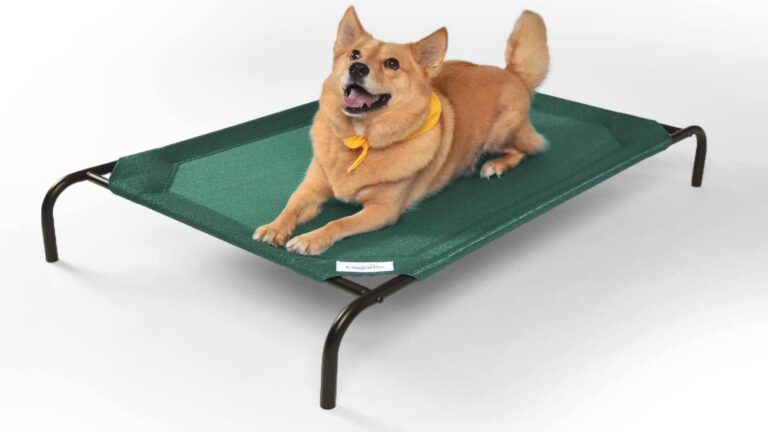For aging or injured dogs, a good night’s sleep is critical for their health and happiness. Orthopedic dog beds are specially designed to provide gentle support for dogs’ joints and bones, helping relieve pain and improve rest.
An orthopedic dog bed contours to your dog’s body shape, cradling its frame and aligning the spine. These therapeutic beds evenly distribute your dog’s weight to reduce pressure on joints, hips, elbows, and other sensitive areas. They are made with denser memory foam that offers enhanced cushioning and support compared to a regular dog bed.
Orthopedic beds for dogs can make a huge difference for senior dogs or those suffering from arthritis, hip dysplasia, mobility issues, or recovery from surgery. The improved cushioning and stability help ease aches and pains, increase the range of motion, and give dogs the deep, restorative sleep they need.
If your furry friend is having trouble settling in at night or seems stiff and sore, an orthopedic dog bed could be the solution. Read on to learn more about the benefits of these specially designed beds for man’s best friend.
Benefits of Orthopedic Dog Beds

An orthopedic dog bed offers targeted support that can make a big difference in your dog’s comfort, mobility, and quality of life. Some key benefits of orthopedic beds include:
Relieve Aches and Pains
Orthopedic dog beds can work wonders for dogs suffering from sore joints, arthritis, hip dysplasia, and mobility issues. The contouring memory foam cushions joints aligns the spine, and distributes your dog’s weight evenly. This takes pressure off sensitive areas like the hips, shoulders, and elbows where dogs tend to develop painful bone calluses. The improved support and stability can help reduce inflammation and make dogs with arthritis more comfortable.
Improve Mobility
For senior or disabled dogs who struggle to get around comfortably, an orthopedic bed can improve mobility and range of motion. Older dogs often develop stiffness and limited flexibility. The cradling support of an orthopedic bed makes it easier for them to get up, stretch out, and reposition themselves. These beds also provide the restorative sleep older dogs need to heal and stay active.
Aid Recovery
Dogs recovering from surgery, joint injuries, or mobility-related conditions will benefit from the stable cushioning of an orthopedic bed. The memory foam conforms gently around the affected areas to limit jarring movements and reduce the chance of re-injury. Dogs can fully relax their muscles and joints after physical therapy or activity in the peaceful comfort of an orthopedic bed.
Prevent Sores
Without proper cushioning and support, dogs can develop painful pressure sores on bony areas like their hips, elbows, and heels. Orthopedic beds evenly distribute a dog’s weight so there are no concentrated pressure points. This keeps blood circulating to prevent sores from developing. The foam also keeps the skin and coat aerated so dogs don’t overheat.
Features of Orthopedic Dog Beds
Orthopedic dog beds are specially designed with therapeutic features to provide optimal joint and muscle support. Some of the key features to look for in an orthopedic bed include:
Contouring Memory Foam
At the core of an orthopedic dog bed is a high-density memory foam that molds precisely to your dog’s body shape, providing customized support. This responsive foam cushioning allows proper alignment of the spine and joints. A density of at least 2 pounds per cubic foot offers the best comfort and resilience.
Egg Crate or Gel Foam Toppers
For additional soothing comfort, many orthopedic beds have a layer of gel foam or egg crate foam on top of the base memory foam. This provides extra cushioning and improves air circulation, keeping your dog cool.
Removable Covers
Quality orthopedic beds have removable, washable outer covers so you can easily keep the bed fresh and clean. Some covers also have a waterproof interior lining for dogs that have occasional accidents.
Supportive Bolsters
Bolstered edges on the bed provide additional support and a sense of security for dogs. They can rest their head on the raised sides and nestle into the surrounding foam walls.
Non-Slip Base
To prevent sliding around on hard floors, orthopedic beds have a textured non-skid rubber base. This keeps the bed securely in position for safe stepping on and off.
Choosing the Right Orthopedic Dog Bed
Selecting the ideal orthopedic dog bed requires taking into account your dog’s unique needs and sleeping habits. Some key factors to consider when choosing an orthopedic bed are:
Consider Your Dog’s Needs
Take into account your dog’s weight, health issues, and preferred sleeping positions when selecting an orthopedic bed. Heavier dogs need a denser foam core while older dogs need ample joint and neck support. Measure your dog’s sleeping to ensure the bed accommodates their size and sleeping style.
Assess the Foam
Look for high-density memory foam with an indentation load deflection (ILD) rating suitable for your dog’s weight. Heavier dogs need a firmer foam density while lighter dogs do better with a softer feel. Test the foam by pressing your hand in – it should be supportive yet have some give.
Get Durable, Washable Covers
For dogs that tend to chew or claw bed covers, look for ripped-proof ballistic nylon or other chew-resistant fabrics. For senior or incontinent dogs, choose covers with waterproof linings and that are fully machine washable for easy cleaning.
Consult Your Vet
For dogs with severe joint issues or recovery needs, get input from your veterinarian on ideal foam densities, bed features, and additional orthopedic support products. Custom beds can be made to accommodate medical devices or braces.
Tips for Using an Orthopedic Dog Bed
To maximize the benefits of an orthopedic dog bed, there are a few useful care and placement tips to know. Some recommendations for using an orthopedic bed include:
Find the Right Spot
Place the orthopedic bed in a quiet, low-traffic area without obstacles for easy access. Dogs are more likely to use the bed if it’s in their favorite sleeping spot.
Clean Covers Frequently
Wash covers weekly to keep the bed fresh and hygienic. Spot clean any accidents immediately. Replace worn covers every 6-12 months to maintain support and comfort.
Rotate and Fluff Foam
To prevent flattening, rotate or flip the foam core periodically. Fluff and massage the foam to maintain its loft and shape.
Use a Waterproof Liner
For senior or accident-prone dogs, use an orthopedic cover with a waterproof interior lining to manage accidents.
Mix It Up
Alternate between the orthopedic bed and a soft, portable bed to give your dog some variety and mobility.
Encourage Use
Entice your dog to use their new bed by sprinkling treats on it or spraying it with their own scent or calming pheromones.
Conclusion
Orthopedic dog beds are specially engineered to provide optimal joint and bone support for canine companions. The responsive memory foam cushions and aligns the body, easing discomfort and improving rest. These therapeutic beds distribute weight evenly, reducing pressure on sensitive spots prone to sores or calluses.
When selecting an orthopedic dog bed, carefully consider your dog’s size, health issues, and sleeping habits. Look for high-density foam with removable, durable covers to suit their needs. Get input from your veterinarian for dogs with mobility limitations or medical conditions.
Senior dogs, those recovering from surgery, and pups with joint problems or arthritis stand to benefit the most from orthopedic support. The improved comfort and stability can extend their active years and mobility. With the right orthopedic bed, your dog will be resting easily and awake ready for adventure.
FAQs about orthopedic dog beds
What Makes a Dog Bed Orthopedic?
Orthopedic dog beds are made with high-density memory foam that cushions joints and aligns the spine. The responsive foam molds to the dog’s body shape, distributing weight evenly. Other features like egg crate or gel foam toppers, bolstered edges, and non-slip bases provide additional support and stability. The materials used and construction techniques distinguish orthopedic beds from regular dog beds.
Are Orthopedic Dog Beds Worth It?
For dogs with arthritis, joint injuries, or mobility issues, orthopedic beds are absolutely worth the investment. The improved support and comfort can reduce pain, improve flexibility, and give dogs a better quality of life. Orthopedic beds are also beneficial for large or heavy dogs prone to joint stress and seniors who require gentle support.
Do Dogs Need Orthopedic Beds?
While all dogs can enjoy the comfort of an orthopedic bed, they are most beneficial for seniors, dogs with arthritis, mobility limitations, or recovering from surgery. The therapeutic materials provide the precise joint and muscle support these dogs need. Check with your vet if you are unsure whether your dog could benefit from orthopedic support.
Should I Get an Orthopedic Bed for My Dog?
Consider an orthopedic bed if your dog struggles to get comfortable at night, seems stiff when rising, or has trouble with stairs or jumping. The signs of arthritis and joint pain often emerge slowly. An orthopedic bed can provide preventative support before major mobility issues arise.
What Are Orthopedic Dog Beds Made Of?
Orthopedic dog beds feature a high-density memory foam base layer with an indentation load deflection (ILD) rating optimal for the dog’s size and weight. This base is topped with softer memory foam, egg crate foam, or gel foam for additional cushioning. Wrapping the foam is a removable and washable cover.
How Do Orthopedic Dog Beds Work?
The memory foam in orthopedic beds conforms precisely to the natural contours of a dog’s body, aligning the spine and cushioning joint pressure points. This provides stability, eases discomfort, and improves sleep quality. The improved support helps relieve pain and inflammation.
How Do I Choose an Orthopedic Dog Bed?
Consider your dog’s weight, health, and sleep habits. Measure your dog’s length when sleeping. Assess foam density and thickness. Look for durable, waterproof covers. For arthritis and mobility issues, consult your veterinarian on size, foam type, and additional orthopedic features needed. Learn more to choose the right dog bed.
Learn more about dog beds
Are Dog Beds Made in China Dangerous?








